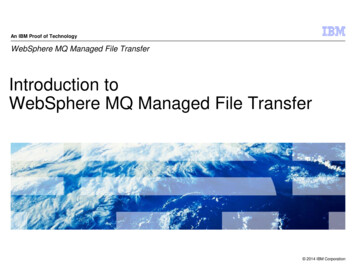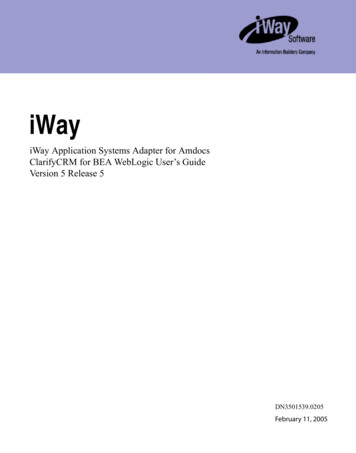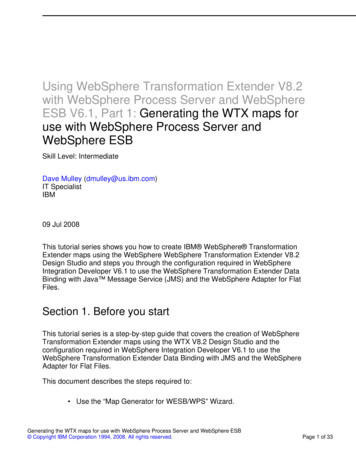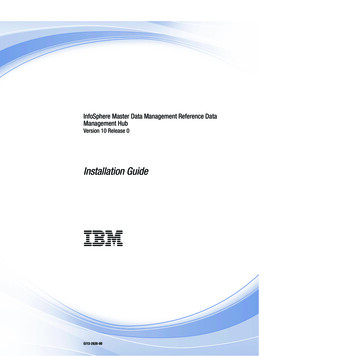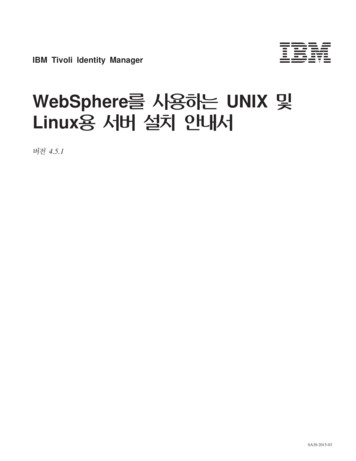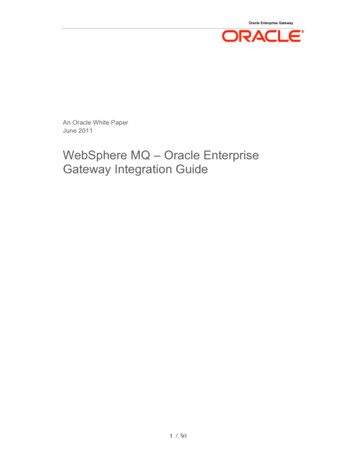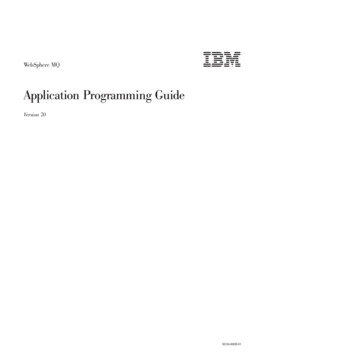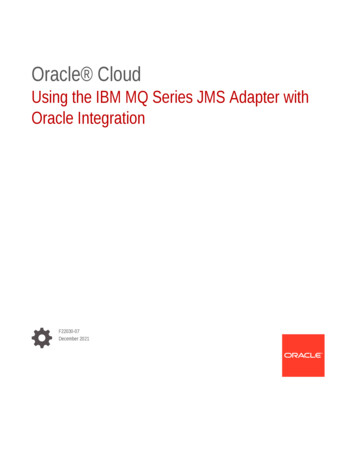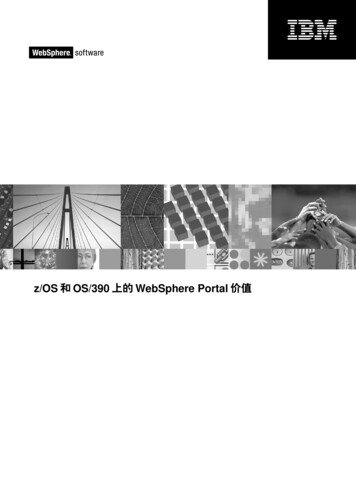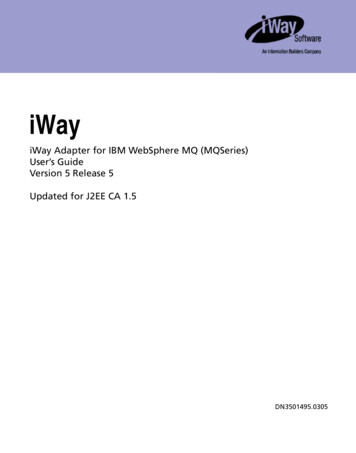
Transcription
iWayiWay Adapter for IBM WebSphere MQ (MQSeries)User’s GuideVersion 5 Release 5Updated for J2EE CA 1.5DN3501495.0305
EDA, EDA/SQL, FIDEL, FOCCALC, FOCUS, FOCUS Fusion, FOCUS Vision, Hospital-Trac, Information Builders, the Information Builders logo,Parlay, PC/FOCUS, SmartMart, SmartMode, SNAPpack, TableTalk, WALDO, Web390, WebFOCUS and WorldMART are registered trademarks,and iWay and iWay Software are trademarks of Information Builders, Inc.Sun and Java are trademarks or registered trademarks of Sun Microsystems, Inc. in the U.S. and other countries.Due to the nature of this material, this document refers to numerous hardware and software products by their trademarks. In most, if notall cases, these designations are claimed as trademarks or registered trademarks by their respective companies. It is not this publisher’sintent to use any of these names generically. The reader is therefore cautioned to investigate all claimed trademark rights before using anyof these names other than to refer to the product described.Copyright 2005, by Information Builders, Inc and iWay Software. All rights reserved. Patent Pending. This manual, or parts thereof, maynot be reproduced in any form without the written permission of Information Builders, Inc.
PrefaceThis document is written for system integrators who develop client interfaces between IBMWebSphere MQ (MQSeries) and other applications. It describes how to use the iWayAdapter for IBM WebSphere MQ (MQSeries) to integrate the MQSeries queue with the SunJava System Application Server. It is assumed that readers understand Web technologiesand have a general understanding of Microsoft Windows and UNIX systems.How This Manual Is OrganizedThe following table lists and describes the chapters in this manual.ChapterContents1Introducing the iWayAdapter for IBMWebSphere MQ(MQSeries)Provides an overview of the iWay Adapter for IBMWebSphere MQ (MQSeries) and discusses key featuresand functionality.2Creating XML Schemasor Web Services for IBMWebSphere MQ(MQSeries)Describes how to use iWay Servlet ApplicationExplorer as deployed to a Sun Java System ApplicationServer.3Listening for EventsDescribes how to use iWay Servlet ApplicationExplorer to listen for events.4Using Web ServicesPolicy-Based SecurityDescribes how Web services policy-based securityworks and how to configure it.5Management andMonitoringDescribes how you can use managing and monitoringtools provided by iBSE and JCA to gauge theperformance of your run-time environment.iWay Adapter for IBM WebSphere MQ (MQSeries) User’s Guideiii
What You Need to KnowThis document is written for system integrators who develop client-server interfacesbetween MQSeries and other applications. The iWay Adapter for IBM WebSphere MQ(MQSeries) provides a means to exchange real-time business data between MQSeriessystems and other application, database, or external business partner systems. The adapterallows for inbound and outbound processing with MQSeries. It is assumed that readershave: General knowledge of the MQSeries environment and how to configure MQSeriestasks. General knowledge of MQSeries EAI concepts. Specific knowledge of MQSeries business applications. Knowledge of MQSeries processes and data models for the required application area. General knowledge of client-server concepts.Requirementsiv Installation of the proper iWay components. Developer access to MQSeries interfaces and components.iWay Software
PrefaceDocumentation ConventionsThe following table lists and describes the conventions that apply in this manual.ConventionDescriptionTHIS TYPEFACE orthis typefaceDenotes syntax that you must enter exactly as shown.this typefaceRepresents a placeholder (or variable) in syntax for a value thatyou or the system must supply.underscoreIndicates a default setting.this typefaceRepresents a placeholder (or variable) in a text paragraph, across-reference, or an important term.this typefaceHighlights a file name or command in a text paragraph thatmust be lowercase.this typefaceIndicates a button, menu item, or dialog box option you canclick or select.Key KeyIndicates keys that you must press simultaneously.{Indicates two or three choices; type one of them, not thebraces.} Separates mutually exclusive choices in syntax. Type one ofthem, not the symbol.Indicates that you can enter a parameter multiple times. Typeonly the parameter, not the ellipsis points ( ).Indicates that there are (or could be) intervening or additionalcommands.Customer SupportDo you have questions about iWay Adapter for IBM WebSphere MQ (MQSeries)?If you bought the product from a vendor other than iWay Software, contact yourdistributor.iWay Adapter for IBM WebSphere MQ (MQSeries) User’s Guidev
If you bought the product directly from iWay Software, call Information Builders CustomerSupport Service (CSS) at (800) 736-6130 or (212) 736-6130. Customer Support Consultantsare available Monday through Friday between 8:00 a.m. and 8:00 p.m. EST to address allyour iWay Adapter for IBM WebSphere MQ (MQSeries) questions. Information Buildersconsultants can also give you general guidance regarding product capabilities anddocumentation. Please be ready to provide your six-digit site code number (xxxx.xx) whenyou call.You can also access support services electronically, 24 hours a day, with InfoResponseOnline. InfoResponse Online is accessible through our World Wide Web site, http://www.informationbuilders.com. It connects you to the tracking system and known-problemdatabase at the Information Builders support center. Registered users can open, update,and view the status of cases in the tracking system and read descriptions of reportedsoftware issues. New users can register immediately for this service. The technical supportsection of www.informationbuilders.com also provides usage techniques, diagnostic tips,and answers to frequently asked questions.To learn about the full range of available support services, ask your Information Buildersrepresentative about InfoResponse Online, or call (800) 969-INFO.viiWay Software
PrefaceHelp Us to Serve You BetterTo help our consultants answer your questions effectively, please be prepared to providespecifications and sample files and to answer questions about errors and problems.The following tables list the specifications our consultants require.PlatformOperating SystemOS VersionProduct ListAdaptersAdapterDeploymentFor example, JCA, Business Services Engine, iWay AdapterManagerContainer VersionThe following table lists components. Specify the version in the column provided.ComponentVersioniWay AdapterEIS (DBMS/APP)HOTFIX / Service PackThe following table lists the types of Application Explorer. Specify the version (and platform,if different than listed previously) in the columns provided.Application ExplorerTypeVersionPlatformSwingServletASPIn the following table, specify the JVM version and vendor in the columns provided.VersionVendoriWay Adapter for IBM WebSphere MQ (MQSeries) User’s Guidevii
The following table lists additional questions to help us serve you better.Request/QuestionError/Problem Details or InformationProvide usage scenarios orsummarize the applicationthat produces the problem.Did this happen previously?Can you reproduce thisproblem consistently?Any change in theapplication environment:software configuration, EIS/database configuration,application, and so forth?Under what circumstancedoes the problem not occur?Describe the steps toreproduce the problem.Describe the problem.Specify the error message(s).The following table lists error/problem files that might be applicable.XML schemaXML instancesOther input documents (transformation)Error screen shotsError output filesTrace and log filesLog transactionviiiiWay Software
PrefaceUser FeedbackIn an effort to produce effective documentation, the Documentation Services staffwelcomes your opinions regarding this manual. Please use the Reader Comments form atthe end of this manual to communicate suggestions for improving this publication or toalert us to corrections. You also can go to our Web site, http://www.iwaysoftware.com anduse the Documentation Feedback form.Thank you, in advance, for your comments.iWay Software Training and Professional ServicesInterested in training? Our Education Department offers a wide variety of training coursesfor iWay Software and other Information Builders products.For information on course descriptions, locations, and dates, or to register for classes, visitour World Wide Web site, http://www.iwaysoftware.com or call (800) 969-INFO to speak toan Education Representative.Interested in technical assistance for your implementation? Our Professional Servicesdepartment provides expert design, systems architecture, implementation, and projectmanagement services for all your business integration projects. For information, visit ourWorld Wide Web site, http://www.iwaysoftware.com.iWay Adapter for IBM WebSphere MQ (MQSeries) User’s Guideix
xiWay Software
Contents1.Introducing the iWay Adapter for IBM WebSphere MQ (MQSeries) . . . . . . . . . . . .1-1Features of the iWay Adapter for IBM WebSphere MQ (MQSeries) . . . . . . . . . . . . . . . . . . . . . . . . . . . . . . .1-2Using the iWay Application Explorer With the iWay Adapter for IBM WebSphere MQ (MQSeries) .1-3Key Features of iWay Application Explorer . . . . . . . . . . . . . . . . . . . . . . . . . . . . . . . . . . . . . . . . . . . . . . . .1-3Installing and Configuring the Servlet iWay Application Explorer . . . . . . . . . . . . . . . . . . . . . . . . . .1-3Deployment Information for the iWay Adapter for IBM WebSphere MQ (MQSeries) . . . . . . . . . . . . . .1-3The iWay Business Services Engine (iBSE) . . . . . . . . . . . . . . . . . . . . . . . . . . . . . . . . . . . . . . . . . . . . . . . . .1-4The iWay Enterprise Connector for J2EE Connector Architecture (JCA) . . . . . . . . . . . . . . . . . . . . .1-4Deployment Information Roadmap . . . . . . . . . . . . . . . . . . . . . . . . . . . . . . . . . . . . . . . . . . . . . . . . . . . . . .1-52.Creating XML Schemas or Web Services for IBM WebSphere MQ (MQSeries) . . .2-1Overview . . . . . . . . . . . . . . . . . . . . . . . . . . . . . . . . . . . . . . . . . . . . . . . . . . . . . . . . . . . . . . . . . . . . . . . . . . . . . . . . . . . . .2-2Starting iWay Servlet Application Explorer . . . . . . . . . . . . . . . . . . . . . . . . . . . . . . . . . . . . . . . . . . . . . . . . . . . . .2-2Establishing a Target for MQSeries . . . . . . . . . . . . . . . . . . . . . . . . . . . . . . . . . . . . . . . . . . . . . . . . . . . . . . . . . . . . .2-3Creating a New Target . . . . . . . . . . . . . . . . . . . . . . . . . . . . . . . . . . . . . . . . . . . . . . . . . . . . . . . . . . . . . . . . . . .2-3Connecting to a Target . . . . . . . . . . . . . . . . . . . . . . . . . . . . . . . . . . . . . . . . . . . . . . . . . . . . . . . . . . . . . . . . . .2-9Disconnecting From a Target . . . . . . . . . . . . . . . . . . . . . . . . . . . . . . . . . . . . . . . . . . . . . . . . . . . . . . . . . . 2-11Modifying a Target . . . . . . . . . . . . . . . . . . . . . . . . . . . . . . . . . . . . . . . . . . . . . . . . . . . . . . . . . . . . . . . . . . . . 2-11Deleting a Target . . . . . . . . . . . . . . . . . . . . . . . . . . . . . . . . . . . . . . . . . . . . . . . . . . . . . . . . . . . . . . . . . . . . . . 2-11Creating a Schema . . . . . . . . . . . . . . . . . . . . . . . . . . . . . . . . . . . . . . . . . . . . . . . . . . . . . . . . . . . . . . . . . . . . . . . . . . 2-13Creating a Web Service . . . . . . . . . . . . . . . . . . . . . . . . . . . . . . . . . . . . . . . . . . . . . . . . . . . . . . . . . . . . . . . . . . . . . 2-15Testing a Web Service for a Business Object . . . . . . . . . . . . . . . . . . . . . . . . . . . . . . . . . . . . . . . . . . . . 2-193.Listening for Events . . . . . . . . . . . . . . . . . . . . . . . . . . . . . . . . . . . . . . . . . . . . . . . . . . . . . . .3-1Understanding iWay Event Functionality . . . . . . . . . . . . . . . . . . . . . . . . . . . . . . . . . . . . . . . . . . . . . . . . . . . . . .3-2Creating an Event Port . . . . . . . . . . . . . . . . . . . . . . . . . . . . . . . . . . . . . . . . . . . . . . . . . . . . . . . . . . . . . . . . . . . . . . . .3-2Editing or Deleting an Event Port . . . . . . . . . . . . . . . . . . . . . . . . . . . . . . . . . . . . . . . . . . . . . . . . . . . . . . 3-13Creating a Channel . . . . . . . . . . . . . . . . . . . . . . . . . . . . . . . . . . . . . . . . . . . . . . . . . . . . . . . . . . . . . . . . . . . . . . . . . 3-144.Using Web Services Policy-Based Security . . . . . . . . . . . . . . . . . . . . . . . . . . . . . . . . . .4-1iWay Business Services Policy-Based Security . . . . . . . . . . . . . . . . . . . . . . . . . . . . . . . . . . . . . . . . . . . . . . . . . .4-2Configuring iWay Business Services Policy-Based Security . . . . . . . . . . . . . . . . . . . . . . . . . . . . . . . . . . . . . .4-3iWay Adapter for IBM WebSphere MQ (MQSeries) User’s Guidexi
Contents5.Management and Monitoring . . . . . . . . . . . . . . . . . . . . . . . . . . . . . . . . . . . . . . . . . . . . . .5-1Managing and Monitoring Services and Events Using iBSE . . . . . . . . . . . . . . . . . . . . . . . . . . . . . . . . . . . . .5-2Managing and Monitoring Services and Events Using the JCA Test Tool . . . . . . . . . . . . . . . . . . . . . . 5-16Setting Engine Log Levels . . . . . . . . . . . . . . . . . . . . . . . . . . . . . . . . . . . . . . . . . . . . . . . . . . . . . . . . . . . . . . . . . . . 5-20Migrating Repositories . . . . . . . . . . . . . . . . . . . . . . . . . . . . . . . . . . . . . . . . . . . . . . . . . . . . . . . . . . . . . . . . . . . . . . 5-22File Repositories . . . . . . . . . . . . . . . . . . . . . . . . . . . . . . . . . . . . . . . . . . . . . . . . . . . . . . . . . . . . . . . . . . . . . . . 5-22iBSE Repositories . . . . . . . . . . . . . . . . . . . . . . . . . . . . . . . . . . . . . . . . . . . . . . . . . . . . . . . . . . . . . . . . . . . . . . 5-22JCA Repositories . . . . . . . . . . . . . . . . . . . . . . . . . . . . . . . . . . . . . . . . . . . . . . . . . . . . . . . . . . . . . . . . . . . . . . 5-26Migrating Event Handling Configurations . . . . . . . . . . . . . . . . . . . . . . . . . . . . . . . . . . . . . . . . . . . . . . 5-26Exporting or Importing Targets . . . . . . . . . . . . . . . . . . . . . . . . . . . . . . . . . . . . . . . . . . . . . . . . . . . . . . . . . . . . . . 5-31Retrieving or Updating Web Service Method Connection Information . . . . . . . . . . . . . . . . . . . . . . . . 5-35Starting or Stopping a Channel Programmatically . . . . . . . . . . . . . . . . . . . . . . . . . . . . . . . . . . . . . . . . . . . . 5-39xiiiWay Software
CHAPTER 1Introducing the iWay Adapter for IBM WebSphere MQ (MQSeries)Topics: Features of the iWay Adapter for IBMWebSphere MQ (MQSeries) Using the iWay Application Explorer With theiWay Adapter for IBM WebSphere MQ(MQSeries) Deployment Information for the iWay Adapterfor IBM WebSphere MQ (MQSeries)The iWay Adapter for IBM WebSphere MQ(MQSeries) provides you with messageconnectivity between Java Applications. Thefollowing section provides an overview of theadapter and discusses key features andfunctionality.iWay Adapter for IBM WebSphere MQ (MQSeries) User’s Guide1-1
Features of the iWay Adapter for IBM WebSphere MQ (MQSeries)Features of the iWay Adapter for IBM WebSphere MQ (MQSeries)The IBM WebSphere (formerly MQSeries ) messaging products enable applicationintegration by helping business applications to exchange information across differentplatforms by sending and receiving data as messages. WebSphere consists of Native MQand MQSeries JMS (MQJMS). These products take care of network interfaces, assure onceonly delivery of messages, deal with communication protocols, dynamically distributeworkloads across available resources, handle recovery after system problems occur, andhelp make programs portable. These actions are performed so that programmers can usetheir skills to handle key business requirements, instead of wrestling with underlyingnetwork complexities.Using the iWay Adapter for IBM WebSphere MQ (MQSeries), your application can readmessages arriving on a named queue, and route the responses to either another queue orto a non-MQ destination. Similarly, messages received through any channel can be directedto an MQ queue. During the message flow, the adapter can apply the standard documentanalysis, validation, transformation, and business logic capabilities to the message. Anoptional pending facility ensures that messages are retried if appropriate resources are notavailable at the time of execution.The adapter also supports queue operations using the WebSphere client, so that each userdoes not need to install the full IBM WebSphere Server product.Message Queuing provides applications with reliable communication and efficient use ofnetwork resources. Developers can focus on business logic instead of networking issues,because Message Queuing guarantees network communication. Services: Applications use this capability to direct messages to an MQSeries queue. Events: Applications use this capability to read messages arriving on an MQSeriesqueue.After deployment, the iWay Adapter for IBM WebSphere MQ (MQSeries):1-2 Provides bi-directional message interactions and transactional support, facilitating theexchange of messages between IBM WebSphere MQSeries queues and otherenterprise systems. Enables an application to read messages arriving on a queue and route those messagesto another queue or to a non-MQSeries destination. Includes the iWay Application Explorer, a GUI tool that enables the configuration of theadapter. Enables messages to be directed to a named queue.iWay Software
Introducing the iWay Adapter for IBM WebSphere MQ (MQSeries)Using the iWay Application Explorer With the iWay Adapter for IBMWebSphere MQ (MQSeries)The iWay Application Explorer uses an explorer metaphor for browsing objects. Theexplorer enables you to create XML schemas and Web services for interaction with anMQSeries system. External applications that interact with an MQSeries system through theiWay Adapter for IBM WebSphere MQ (MQSeries) use either XML schemas or Web servicesto pass data between the external application and the adapter.External applications accessing an MQSeries queue via the iWay Adapter for IBMWebSphere MQ (MQSeries) use either the XML schema or Web service to pass databetween the external application and the adapter.The steps required to create XML schemas for Web services are illustrated in Chapter 2,Creating XML Schemas or Web Services for IBM WebSphere MQ (MQSeries).Key Features of iWay Application ExplorerKey features of iWay Application Explorer include: The ability to connect to and explore a variety of application systems. Access to application system object metadata. A point-and-click process for generating XML schemas and Web services.Installing and Configuring the Servlet iWay Application ExploreriWay Application Explorer must be deployed through a servlet container or applicationserver (for example, Sun Java System Application Server, BEA WebLogic, Apache Tomcat,SAP J2EE Engine, or IBM WebSphere).In addition, the MQSeries system must be installed, configured, and available for clientaccess. Application Explorer need not reside on the same system as the MQSeries system,but network access is required.For more information on installing and configuring the Java Servlet iWay ApplicationExplorer, see the iWay 5.5 Installation and Configuration documentation.Deployment Information for the iWay Adapter for IBM WebSphere MQ(MQSeries)The iWay Adapter for IBM WebSphere MQ (MQSeries) works in conjunction with iWayApplication Explorer with either of the following components: iWay Business Services Engine (iBSE) iWay Enterprise Connector for J2EE Connector Architecture (JCA)iWay Adapter for IBM WebSphere MQ (MQSeries) User’s Guide1-3
Deployment Information for the iWay Adapter for IBM WebSphere MQ (MQSeries)iWay Application Explorer, used to configure MQSeries connections and create Webservices and events, can be configured to work in a Web services environment inconjunction with the iWay Business Services Engine or with the iWay Enterprise Connectorfor J2EE Connector Architecture (JCA). When working in a JCA environment, the connectoruses the Common Client Interface (CCI) to provide fast integration services using iWayAdapters instead of using Web services.Both iBSE and the iWay connector for JCA are deployed to an application server with iWayApplication Explorer and the adapters.The iWay Business Services Engine (iBSE)The iWay Business Services Engine (iBSE) exposes—as Web services—enterprise assets thatare accessible from adapters regardless of the programming language or the particularoperating system.iBSE simplifies the creation and execution of Web services when running: Custom and legacy applications Database queries and stored procedures Packaged applications Terminal emulation and screen-based systems Transactional systemsWeb services is a distributed programming architecture that solves Enterprise ApplicationIntegration (EAI) hurdles that other programming models cannot. It enables programs tocommunicate with one another using a text-based, platform- and language-independentmessage format called XML.Coupled with a platform and language independent messaging protocol called SOAP(Simple Object Access Protocol), XML enables application development and integration byassembling previously built components from multiple Web services.The iWay Enterprise Connector for J2EE Connector Architecture (JCA)The iWay Enterprise Connector for J2EE Connector Architecture (JCA) enables developers ofJCA-compliant applications to deploy iWay adapters as JCA resources. The connector issupported on J2EE-compliant application servers such as Sun Java System ApplicationServer.The iWay Connector for JCA is distributed as a standard Resource Adapter Archive (RAR) fordeployment to the application server. Thus, the connector can be used in systems that arenon-compliant, although services such as pooled connections are not available.1-4iWay Software
Introducing the iWay Adapter for IBM WebSphere MQ (MQSeries)Two connectors are distributed in the iWay installation package. One conforms to the JCA1.0 specification, with extensions that allow for the consumption of events. The otherconforms to the JCA 1.5 specification. The JCA 1.0 connector provides for eventfunctionality through the configuration of ports and channels. When using the adapter inconjunction with a JCA 1.5 connector, there is no need to create event ports to dispose ofevent data. However, you must create a channel to enable event listening capabilities. Formore information on event capabilities of the iWay JCA connectors, see Chapter 3, Listeningfor Events. For more information on installing and deploying both connectors, see iWayInstallation and Configuration.Deployment Information RoadmapThe following table lists the location of deployment information for the iWay Adapter forIBM WebSphere MQ (MQSeries). A description of the iWay Business Services Engine (iBSE)and the iWay Enterprise Connector for J2EE Connector Architecture (JCA) follow the table.Deployed ComponentFor more information, seeiWay Application Explorer Chapters 2 and 3 of this guide iWay Installation and Configuration iWay Servlet Application Explorer User’sGuideiWay Business Services Engine (iBSE) iWay Installation and ConfigurationiWay Enterprise Connector for J2EEConnector Architecture (JCA) iWay Connector for JCA User’s Guide iWay Installation and ConfigurationiWay Adapter for IBM WebSphere MQ (MQSeries) User’s Guide1-5
Deployment Information for the iWay Adapter for IBM WebSphere MQ (MQSeries)1-6iWay Software
CHAPTER 2Creating XML Schemas or Web Services for IBM WebSphere MQ(MQSeries)Topics: Overview Starting iWay Servlet Application Explorer Establishing a Target for MQSeries Creating a Schema Creating a Web ServiceThis section describes how to use iWay ServletApplication Explorer to create XML schemas orWeb services as deployed to a Sun Java SystemApplication Server.iWay Adapter for IBM WebSphere MQ (MQSeries) User’s Guide2-1
OverviewOverviewExternal applications that access MQSeries through the adapter use either XML schemas orWeb services to pass data between the external application and the adapter. You can useiWay Servlet Application Explorer to create the required XML schemas and Web services.Application Explorer is a Web application running within a servlet container that isaccessible through a Web browser. For more information on installing and configuring theiWay Servlet Application Explorer, see the iWay 5.5 Installation and Configurationdocumentation.IBM WebSphere MQ must be installed, configured, and available for client access.Application Explorer need not reside on the same system as the application system beingaccessed, but network access is required.Starting iWay Servlet Application ExplorerBefore you can use iWay Servlet Application Explorer, you must start the Sun Java SystemApplication Server. Then, you can open Application Explorer.Procedure: How to Open iWay Servlet Application ExplorerTo open Application Explorer:1. Enter the following URL in your browser ostnameIs the name of the machine where your application server is running.portIs the port where the application server is listening.2-2iWay Software
Creating XML Schemas or Web Services for IBMAfter you open Application Explorer, the following Welcome window opens, showingthe iWay Adapters, iWay Events, and iWay Business Services tabs. The iWay Adaptersnode is highlighted in the left pane as shown in the following image.The Available Hosts drop-down menu in the upper right lists the iWay Connector forJCA or Servlet iBSE instance you can access.For more information on adding instances, see the iWay 5.5 Installation and Configurationdocumentation.You are now ready to create new targets for MQSeries.Establishing a Target for MQSeriesA target serves as your connection point and is automatically saved after you create it. Youmust establish a connection to MQSeries every time you start iWay Application Explorer orafter you disconnect from the system.Creating a New TargetTo connect to MQSeries for the first time, you must create a new target.iWay Adapter for IBM WebSphere MQ (MQSeries) User’s Guide2-3
Establishing a Target for MQSeriesProcedure: How to Create a New TargetThe following image shows the list of supported adapters in the left pane and informationabout the selected adapter in the right pane.To create a new target:1. In the left pane, click the MQ node.Descriptive information (for example, title and product version) for the iWay Adapterfor IBM WebSphere MQ (MQSeries) appears in the right pane as shown in the followingimage.2-4iWay Software
Creating XML Schemas or Web Services for IBM2. In the right pane, move the pointer over Operations and select Define a new target.The Add a new MQ target pane opens on the right as shown in the following image.a. In the Target Name field, type a descriptive name for the new target.b. In the Description field, type a brief description of the target.c.From the Target Type drop-down list, select MQSeries to specify that you areconnecting to an IBM WebSphere MQ system.iWay Adapter for IBM WebSphere MQ (MQSeries) User’s Guide2-5
Establishing a Target for MQSeries3. Click Next.The Set connection info pane where you enter connection information for the targetappears on the right, as shown in the following image.2-6iWay Software
Creating XML Schemas or Web Services for IBM4. Provide information for the IBM WebSphere MQ parameters that are listed anddescribed in the following table.ParameterDescriptionQueue ManagerName of the MQSeries queue manager.QueueCase-sensitive name of the queue where requestdocuments are received. Queues are namedmessage repositories upon which messagesaccumulate until they are retrieved by programsthat service those queues. Queues are managedby, a queue manager.Correlation IDThe Correlation Id of the message to be received.Enter a value in valid hexadecimal string format.Correlation ID TagHostHost on which the MQ Server is located (MQ Clientonly).PortNumber to connect to an MQ Server QueueManager (MQ Client only).ChannelCase-sensitive name of the channel that connectswith the remote MQ Server queue manager. UseSYSTEM.DEF.SVRCONN.Report QueueDestination to which MQSeries must sendrequested CODs and COAs.PrioritySets the message priority level. The lowest priorityis 0 and the highest priority is 9.ExpiryDetermines the length of time the message mustremain on the queue waiting to be retrieved, intenths of a second.CCSIDSpecifies the coded character set number to beused, overriding the machine configured CCSID. Ifomitted, the configured CCSID is used.FormatDetermines the format used for message data. Theavailable choices include None, String, orMQRFH2.iWay Adapter for IBM WebSphere MQ (MQSeries) User’s Guide2-7
Establishing a Target for MQSeriesParameterDescriptionTypeThe options in the drop-down list are datagram,request, or response.PersistThe options in the drop-down list are queue,persistent, or non-persistent.reqcoaSets the report property of an outgoing MQSeriesmessage to request that a Confirmation of Arrival(COA) is sent to the report queue. The options inthe drop-down list are none, nodata, partial, or full.reqcodSets the report property of an outgoing MQSeriesmessage to request that a Confirmation ofDelivery (COD) is sent to the report queue. Theoptions in the drop-down list are none, nodata,partial, or full.Return status or in
WebSphere MQ (MQSeries) and discusses key features and functionality. 2 Creating XML Schemas or Web Services for IBM WebSphere MQ . Describes how you can use managing and monitoring tools provided by iBSE and JCA to gauge the performance of your run-time environment. iv iWay Software

